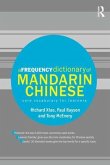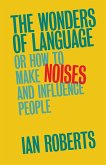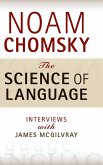Dagmar Divjak
Frequency in Language
Dagmar Divjak
Frequency in Language
- Gebundenes Buch
- Merkliste
- Auf die Merkliste
- Bewerten Bewerten
- Teilen
- Produkt teilen
- Produkterinnerung
- Produkterinnerung
Re-examines frequency, entrenchment and salience, three foundational concepts in usage-based linguistics, through the prism of learning, memory, and attention.
Andere Kunden interessierten sich auch für
![Words beginning with A (Vol. 1). Words beginning with E and I (Vol. 2) Words beginning with A (Vol. 1). Words beginning with E and I (Vol. 2)]() Jaan PuhvelWords beginning with A (Vol. 1). Words beginning with E and I (Vol. 2)170,99 €
Jaan PuhvelWords beginning with A (Vol. 1). Words beginning with E and I (Vol. 2)170,99 €![A Frequency Dictionary of Mandarin Chinese A Frequency Dictionary of Mandarin Chinese]() Richard XiaoA Frequency Dictionary of Mandarin Chinese202,99 €
Richard XiaoA Frequency Dictionary of Mandarin Chinese202,99 €![The Wonders of Language The Wonders of Language]() Ian RobertsThe Wonders of Language28,99 €
Ian RobertsThe Wonders of Language28,99 €![Language Transfer Language Transfer]() Terence OdlinLanguage Transfer58,99 €
Terence OdlinLanguage Transfer58,99 €![The Science of Language The Science of Language]() The Science of Language87,99 €
The Science of Language87,99 €![Language Diversity and Thought Language Diversity and Thought]() John A. LucyLanguage Diversity and Thought51,99 €
John A. LucyLanguage Diversity and Thought51,99 €![Language and History in the Early Germanic World Language and History in the Early Germanic World]() Dennis Howard GreenLanguage and History in the Early Germanic World67,99 €
Dennis Howard GreenLanguage and History in the Early Germanic World67,99 €-
-
-
Re-examines frequency, entrenchment and salience, three foundational concepts in usage-based linguistics, through the prism of learning, memory, and attention.
Hinweis: Dieser Artikel kann nur an eine deutsche Lieferadresse ausgeliefert werden.
Hinweis: Dieser Artikel kann nur an eine deutsche Lieferadresse ausgeliefert werden.
Produktdetails
- Produktdetails
- Verlag: Cambridge University Press
- Seitenzahl: 342
- Erscheinungstermin: 10. Oktober 2019
- Englisch
- Abmessung: 235mm x 157mm x 23mm
- Gewicht: 647g
- ISBN-13: 9781107085756
- ISBN-10: 1107085756
- Artikelnr.: 55389358
- Herstellerkennzeichnung
- Libri GmbH
- Europaallee 1
- 36244 Bad Hersfeld
- gpsr@libri.de
- Verlag: Cambridge University Press
- Seitenzahl: 342
- Erscheinungstermin: 10. Oktober 2019
- Englisch
- Abmessung: 235mm x 157mm x 23mm
- Gewicht: 647g
- ISBN-13: 9781107085756
- ISBN-10: 1107085756
- Artikelnr.: 55389358
- Herstellerkennzeichnung
- Libri GmbH
- Europaallee 1
- 36244 Bad Hersfeld
- gpsr@libri.de
Dagmar Divjak is a Professorial Research Fellow at the University of Birmingham where she holds a Chair in Cognitive Linguistics and Language Cognition. She is Editor-in-Chief of the journal Cognitive Linguistics and co-editor of Handbook of Cognitive Linguistics (2015, with Ewa D¿browska) and author of Structuring the Lexicon (2010).
Introduction: 1. Frequency of experience
2. A cognitive perspective on language
3. What this book is not about
4. What this book is about
Part I: 5. Counting occurrences: how frequency made its way into the study of language
5.1. The frequency wars: the role of frequency in nativist and nurturist frameworks
5.2. Lexical statistics and word (frequency) lists
5.3. Word lists in psycholinguistics: the discovery of the (word) frequency effect
5.4. Word frequency distributions and the beginning of quantitative linguistics
5.5. Summary and outlook
6. Measuring exposure: frequency as s linguistic game-changer
6.1 Frequency and usage-based theories of language
6.2. Frequency measures that have played an important role in the development of usage-based theories of language
6.3. Summary and outlook
7. More than frequencies: towards a probabilistic view on language
7.1. Constructing a grammar from the ground up
7.2. probabilistic grammar
7.3. Probabilities link linguistics to information theory
7.4. Summary and outlook
Part II: 8. Committing experiences to memory
8.1. What is memory?
8.2. The physiology or neurobiology of memory
8.3. Memory systems, memory processes and neural mechanisms of memory storage
8.4. Behavioural diagnostics of memory for language
8.5. Summary and outlook
9. Entrenching linguistic structures
9.1. Entrenchment in the mind, or in society?
9.2. Three types of entrenchment
9.3. How are repeated experiences recorded?
9.4. Frequently asked questions
9.5. Summary and outlook
Part III: 10. The brain's attention-orienting mechanisms
10.1. Grasping the phenomenon: what is attention and what does it do?
10.2. Ways of deploying attention
10.3. Attention and memory: encoding and retrieving information
10.4. Summary and outlook
11. Salience: capturing attention in and through language
11.1. Capturing attention in language: linguistics versus psychology
11.2. Attention and salience
11.3. Conclusions and outlook
Part IV: 12. Predicting: using past experience to guide future action
12.1. Predicting from stored memories
12.2. Memoryless prediction: Bayesian predictive coding frameworks
12.3. What does predictive processing mean for language cognition? 12.4. Conclusions and outlook
13. Learning: navigating frequency, recency, context and contingency
13.1. Background: learning theory
13.2 Applications to linguistics
13.3. Conclusions: the place of frequency in a learning theoretic approach to language
14. Conclusions
14.1. Why do frequencies of occurrence play an important role in usage-based linguistics?
14.2 How can frequency be used to explain the construction of a grammar from the ground up?
14.3. Memory, attention and learning in the emergence of grammar
14.4. Looking forward: what lessons can we learn?
14.5. By way of conclusion.
2. A cognitive perspective on language
3. What this book is not about
4. What this book is about
Part I: 5. Counting occurrences: how frequency made its way into the study of language
5.1. The frequency wars: the role of frequency in nativist and nurturist frameworks
5.2. Lexical statistics and word (frequency) lists
5.3. Word lists in psycholinguistics: the discovery of the (word) frequency effect
5.4. Word frequency distributions and the beginning of quantitative linguistics
5.5. Summary and outlook
6. Measuring exposure: frequency as s linguistic game-changer
6.1 Frequency and usage-based theories of language
6.2. Frequency measures that have played an important role in the development of usage-based theories of language
6.3. Summary and outlook
7. More than frequencies: towards a probabilistic view on language
7.1. Constructing a grammar from the ground up
7.2. probabilistic grammar
7.3. Probabilities link linguistics to information theory
7.4. Summary and outlook
Part II: 8. Committing experiences to memory
8.1. What is memory?
8.2. The physiology or neurobiology of memory
8.3. Memory systems, memory processes and neural mechanisms of memory storage
8.4. Behavioural diagnostics of memory for language
8.5. Summary and outlook
9. Entrenching linguistic structures
9.1. Entrenchment in the mind, or in society?
9.2. Three types of entrenchment
9.3. How are repeated experiences recorded?
9.4. Frequently asked questions
9.5. Summary and outlook
Part III: 10. The brain's attention-orienting mechanisms
10.1. Grasping the phenomenon: what is attention and what does it do?
10.2. Ways of deploying attention
10.3. Attention and memory: encoding and retrieving information
10.4. Summary and outlook
11. Salience: capturing attention in and through language
11.1. Capturing attention in language: linguistics versus psychology
11.2. Attention and salience
11.3. Conclusions and outlook
Part IV: 12. Predicting: using past experience to guide future action
12.1. Predicting from stored memories
12.2. Memoryless prediction: Bayesian predictive coding frameworks
12.3. What does predictive processing mean for language cognition? 12.4. Conclusions and outlook
13. Learning: navigating frequency, recency, context and contingency
13.1. Background: learning theory
13.2 Applications to linguistics
13.3. Conclusions: the place of frequency in a learning theoretic approach to language
14. Conclusions
14.1. Why do frequencies of occurrence play an important role in usage-based linguistics?
14.2 How can frequency be used to explain the construction of a grammar from the ground up?
14.3. Memory, attention and learning in the emergence of grammar
14.4. Looking forward: what lessons can we learn?
14.5. By way of conclusion.
Introduction: 1. Frequency of experience
2. A cognitive perspective on language
3. What this book is not about
4. What this book is about
Part I: 5. Counting occurrences: how frequency made its way into the study of language
5.1. The frequency wars: the role of frequency in nativist and nurturist frameworks
5.2. Lexical statistics and word (frequency) lists
5.3. Word lists in psycholinguistics: the discovery of the (word) frequency effect
5.4. Word frequency distributions and the beginning of quantitative linguistics
5.5. Summary and outlook
6. Measuring exposure: frequency as s linguistic game-changer
6.1 Frequency and usage-based theories of language
6.2. Frequency measures that have played an important role in the development of usage-based theories of language
6.3. Summary and outlook
7. More than frequencies: towards a probabilistic view on language
7.1. Constructing a grammar from the ground up
7.2. probabilistic grammar
7.3. Probabilities link linguistics to information theory
7.4. Summary and outlook
Part II: 8. Committing experiences to memory
8.1. What is memory?
8.2. The physiology or neurobiology of memory
8.3. Memory systems, memory processes and neural mechanisms of memory storage
8.4. Behavioural diagnostics of memory for language
8.5. Summary and outlook
9. Entrenching linguistic structures
9.1. Entrenchment in the mind, or in society?
9.2. Three types of entrenchment
9.3. How are repeated experiences recorded?
9.4. Frequently asked questions
9.5. Summary and outlook
Part III: 10. The brain's attention-orienting mechanisms
10.1. Grasping the phenomenon: what is attention and what does it do?
10.2. Ways of deploying attention
10.3. Attention and memory: encoding and retrieving information
10.4. Summary and outlook
11. Salience: capturing attention in and through language
11.1. Capturing attention in language: linguistics versus psychology
11.2. Attention and salience
11.3. Conclusions and outlook
Part IV: 12. Predicting: using past experience to guide future action
12.1. Predicting from stored memories
12.2. Memoryless prediction: Bayesian predictive coding frameworks
12.3. What does predictive processing mean for language cognition? 12.4. Conclusions and outlook
13. Learning: navigating frequency, recency, context and contingency
13.1. Background: learning theory
13.2 Applications to linguistics
13.3. Conclusions: the place of frequency in a learning theoretic approach to language
14. Conclusions
14.1. Why do frequencies of occurrence play an important role in usage-based linguistics?
14.2 How can frequency be used to explain the construction of a grammar from the ground up?
14.3. Memory, attention and learning in the emergence of grammar
14.4. Looking forward: what lessons can we learn?
14.5. By way of conclusion.
2. A cognitive perspective on language
3. What this book is not about
4. What this book is about
Part I: 5. Counting occurrences: how frequency made its way into the study of language
5.1. The frequency wars: the role of frequency in nativist and nurturist frameworks
5.2. Lexical statistics and word (frequency) lists
5.3. Word lists in psycholinguistics: the discovery of the (word) frequency effect
5.4. Word frequency distributions and the beginning of quantitative linguistics
5.5. Summary and outlook
6. Measuring exposure: frequency as s linguistic game-changer
6.1 Frequency and usage-based theories of language
6.2. Frequency measures that have played an important role in the development of usage-based theories of language
6.3. Summary and outlook
7. More than frequencies: towards a probabilistic view on language
7.1. Constructing a grammar from the ground up
7.2. probabilistic grammar
7.3. Probabilities link linguistics to information theory
7.4. Summary and outlook
Part II: 8. Committing experiences to memory
8.1. What is memory?
8.2. The physiology or neurobiology of memory
8.3. Memory systems, memory processes and neural mechanisms of memory storage
8.4. Behavioural diagnostics of memory for language
8.5. Summary and outlook
9. Entrenching linguistic structures
9.1. Entrenchment in the mind, or in society?
9.2. Three types of entrenchment
9.3. How are repeated experiences recorded?
9.4. Frequently asked questions
9.5. Summary and outlook
Part III: 10. The brain's attention-orienting mechanisms
10.1. Grasping the phenomenon: what is attention and what does it do?
10.2. Ways of deploying attention
10.3. Attention and memory: encoding and retrieving information
10.4. Summary and outlook
11. Salience: capturing attention in and through language
11.1. Capturing attention in language: linguistics versus psychology
11.2. Attention and salience
11.3. Conclusions and outlook
Part IV: 12. Predicting: using past experience to guide future action
12.1. Predicting from stored memories
12.2. Memoryless prediction: Bayesian predictive coding frameworks
12.3. What does predictive processing mean for language cognition? 12.4. Conclusions and outlook
13. Learning: navigating frequency, recency, context and contingency
13.1. Background: learning theory
13.2 Applications to linguistics
13.3. Conclusions: the place of frequency in a learning theoretic approach to language
14. Conclusions
14.1. Why do frequencies of occurrence play an important role in usage-based linguistics?
14.2 How can frequency be used to explain the construction of a grammar from the ground up?
14.3. Memory, attention and learning in the emergence of grammar
14.4. Looking forward: what lessons can we learn?
14.5. By way of conclusion.








